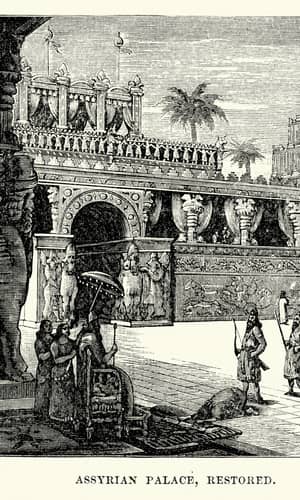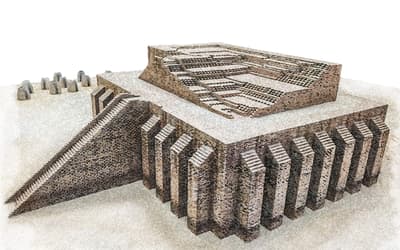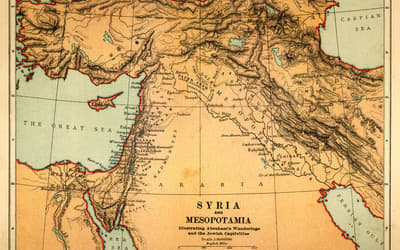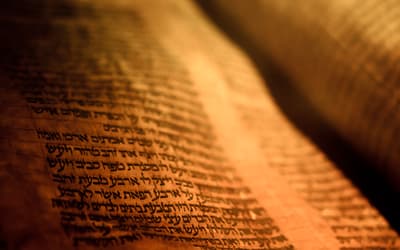The views expressed in this paper are those of the writer(s) and are not necessarily those of the ARJ Editor or Answers in Genesis.
Abstract
This article proposes that in at least 11 different instances, the prophet Nahum alluded to the founding of Nineveh in Genesis 10 and the Tower of Babel account in Genesis 11. These allusions have not received scholarly attention even though they impact interpretation. These allusions place the events of Nahum in the context of God scattering the earliest Mesopotamians. The judgment in Nahum follows the pattern of Babel. God would come down from heaven, incapacitate a rebellion, and scatter the rebels. This hypothesis contradicts the widely-held belief that Nahum declared the annihilation of the Assyrians. As this article shows, the judgments in Nahum result not in extermination, but in dispersion. It is argued that Nahum begins the process in which a remnant from Assyria would be redeemed to worship God, as Isaiah had prophesied decades before.
Keywords: Nahum, Genesis 10–11, Tower of Babel, Table of Nations, Assyria
Introduction
The diminutive and oft-neglected book of Nahum prophesied the fall of the capital of the Assyrian Empire. In Nahum’s lifetime, Nineveh stood as the most ostentatious, feared, and impenetrable city in the world. Decades of pillage had poured gold, silver, cedars, and slaves into the city.2 Three generations of kings used these spoils to expand, gild, reinforce, and arm the capital.3 Yet, Nineveh’s glory proved short-lived.
Nineveh’s prominence in Scripture leads many to exaggerate its importance in Assyria’s history. The city is mentioned in the tenth chapter of the Bible and then is the subject of two entire books. Despite such notable attention, Nineveh served as Assyria’s capital for less than a century (705 BC–612 BC). For most of Assyrian history it languished behind Ashur and Calah. Still, at a time when Nineveh was not yet the capital, the author of Jonah stated, “Now Nineveh was a great city to God” (Jonah 3:3; my literal translation; unless otherwise noted, biblical translations are mine). Its birth merited mention in the Table of Nations. Many centuries later, Nahum would declare its demise.
The nature of this demise is the focus of this article. In Nahum, God revisited an ancient judgment upon an ancient city. What follows will contend that the prophet framed the downfall of Nineveh using imagery from the Tower of Babel. Contrary to the understanding of most commentators, Nahum did not primarily prophesy the slaughter of the Assyrians—he promised their dispersion. This dispersion began the fulfilment of Isaiah’s Assyrian benediction: “Blessed be Egypt my people, and Assyria the work of my hands, and Israel mine inheritance” (Isaiah 19:25 KJV; italics original).
Nahum, the Poet
This investigation begins with the prophet. Nothing is known of Nahum beyond details discerned in the text. He came from Elkosh (1:1)—a town unknown to archaeology (Allis 1955, 76). He lived during the reigns of the most brutal king in Assyria’s history (Ashurbanipal) and the most depraved monarch in Judah’s (Manasseh; 2 Kings 21).4 I have argued elsewhere that Nahum saw his vision in 639 BC (Cook 2016a). Whether or not this is correct, it is well established that Nahum prophesied in the latter half of the seventh century before Christ (Christensen 2009, 52–58).
The text reveals one more biographical detail—one agreed upon by all who have studied the book, regardless of theological commitment. Nahum wrote superb poetry.5 Even his most vocal twentieth-century critic admitted that he
has an unexcelled capacity to bring a situation vividly before the mind’s eye. His constructive imagination lays hold of the central elements of a scene and with realistic imagery and picturesque phraseology recreates it for his readers. Accurate and detailed observation assists in giving his pictures verisimilitude . . . . Through the whole scene there moves a mighty passion and a great joy which lift the narrative out of the commonplace into the majestic and make of it great literature. (Smith 1911, 273–274)
Proper understanding of Nahum depends upon this point.
Nahum’s abilities create a conundrum for modern scholars. Almost every verse contains confusing syntax. An interpreter of the Hebrew has two options: to come humbly before the words or to deem the text defective. Unfortunately, mainstream scholarship usually adopts the latter course without recognizing the inconsistent logic.6 This is done despite textual evidence that “the consonantal text has been handed down with incredible accuracy for nearly two thousand years at least” (Cathcart 1973, 13). The giftedness of the poet and the consistency of the ancient manuscripts both commend the integrity of the book.7 The deficiency is ours, not Nahum’s.
The Scatterer
Unanticipated vocabulary causes much of the confusion. Nahum simply did not write what scholars think he should have. Time after time, Nahum inserted a word that defies the assumed context. One such word points to Babel.
As the book turns to the battle for Nineveh, the text announces God’s principle weapon. The prophet envisioned one man coming against the Assyrian juggernaut and its fortified capital. Nahum called him מֵפִיץ.
Throughout the centuries, translators have struggled to identify this man. The word is a hiphil masculine singular participle of the verb פוץ (“to spread, disperse”). The solitary figure is named as a doer of the verb—he disperses. The King James Version translates מֵפִיץ as “He that dashes in pieces.” The New American Standard Bible calls him, “The one who scatters.” Others deem him “scatterer” (ESV), “shatterer” (NRSV), or “attacker” (NIV).
History records that Nineveh was destroyed in 612 BC. Nebuchadnezzar led the assault of a combined force of Babylonians and Medes—both armies loathed the Assyrians—and took the city in a four-month siege (Cook 2016b, 4–6). The devastation was so total that before Austen Henry Layard uncovered the ruins in 1849, the biblical accounts of the city and empire were considered legendary—or at least exaggerated—by many.8 Therefore, the choice of a word that means “scatterer” strikes scholars as odd.
The confusion stems from misunderstanding Nahum’s purpose. The book is often read as “a violent, nationalistic book, one morally repugnant to modern persons” (O’Brien 2009, 105). Even those who defend the book believe that “God himself decreed the destruction of Assyria. He would make their grave. The whole people would be killed and buried together because they were ‘vile’” (Barker and Bailey 1998, 189). This presupposition, however, is at odds with the text. Hebrew contains many words more suitable to describing the obliteration of a city than “scatterer.” Assuming Nahum chose מֵפִיץ because it most suited his purpose, the annihilation presumption has problems.
At this point a clarification is in order. It is not the creature’s place to question the actions of the Creator. God does not need permission to exercise His judgment. Humans have no authority to question it. The purpose of this article is not to re-read a prophecy in order to excise portions that disagree with modern sensibilities. Many other prophetic passages declare God’s violent judgment. Obadiah, for instance, does decree the obliteration of a rebellious people. The question at hand is merely whether Nahum does as well. “Rightly dividing the word of truth” (2 Timothy 2:15 KJV) requires interpreting the text as it stands—allowing it to speak for itself. Nahum’s words simply do not prophesy the destruction of common Assyrians.
The best proof of this comes from Nahum 3:17–18: Your courtiers are as locusts and your marshals are as swarms of locusts, camping in the walls in a cold day. The sun rises and they are chased away and no one knows where they are. Your shepherds sleep, O king of Assyria. Your nobles are lying down. Your people are scattered upon the mountains and no one gathers them.
As the book culminates, Nahum describes the fate of five groups: courtiers, marshals, shepherds, nobles, and people. Note their state. They either are scattered or sleeping. In the Hebrew, the courtiers, marshals, and people are acted upon. The scatterer has done his job.
Not even the king of Assyria is killed. A careful reading of Nahum shows the enemies of God under judgment and crippled, with the exception of 2:14 (2:13 Eng.), where “a sword will devour your young lions.” The most macabre passage, 3:1–3, depicts countless dead bodies, yet 3:4 demonstrates that the corpses were a result of Nineveh’s lust rather than God’s sword (Achtemeier 1986, 22–23). As the city falls, the population flees (2:9; 2:8 Eng.), the gates are broken (3:13), and the Assyrian sovereign no longer exercises any control over his wayward people (3:17–19). Throughout the book, the military invasion and the resulting destruction of Nineveh results in a scattering, not an obliteration (Cook 2016d, 195–206)
Why would God send מֵפִיץ against Nineveh? Because God planned to redeem an Assyrian remnant. As with Babel, redemption required scattering. Variations on the Hebrew verb פוץ appear in Genesis 11:4 (נַיָּפֶץ), 11:8 (נָפוּץ), and 11:9 (הֱפִיצָם) where the people build the tower as a protection against scattering, yet God proceeds to scatter them. Nahum used one of the most conspicuous and repeated verbs from the Babel narrative to commence the downfall of Nineveh. As in the Babel account, a Mesopotamian people were united in rebellion against God and under the control of a despot. Nahum declared that control shattered. God would liberate the Assyrians from their overlords and disperse them. In Nahum, a single man would come to set Isaiah’s remnant free. He would fulfill in Assyria God’s promise that in Abraham “all families of the earth will be blessed” (Genesis 12:3).
Genesis 10–11
While the above argument begins with the word מֵפיִץ, it does not depend upon it. Nahum invoked allusions from Genesis 10–11 throughout his text. He did this by mimicking syntax from Genesis 10:6, 11, 22, and 11:3–8. This article will now examine these allusions before considering their cumulative importance.
Genesis 10:11
This task begins with Genesis 10:11 and the founding of Nineveh. Because of ambiguity in the Hebrew word אַשּׁוּר, this verse has two possible interpretations. In Hebrew, Genesis 10:11 reads,
מִן־הָאָ֥רֶץ הַהִ֖וא יָצָ֣א אַשּׁ֑וּר וַיִּ֙בֶן֙ אֶת־נִ֣ינְוֵ֔ה וְאֶת־רְחֹבֹ֥ת עִ֖יר וְאֶת־כָּֽלַח׃
In this context, the word אַשּׁוּר could mean either “Asshur,” the patriarch of the Assyrian people (Genesis 10:22), or “Assyria.” Therefore, the verse could be rendered either “Out of that land went forth Asshur, and builded Nineveh, and the city Rehoboth, and Calah” (KJV) or “From that land he [Nimrod] went forth into Assyria, and built Nineveh and Rehoboth-Ir and Calah” (NASB). Both are perfectly valid grammatically. It is not clear whether Asshur the patriarch founded Nineveh or Nimrod did. The principle of interpreting Scripture with Scripture brings Micah 5:5 (5:6 Eng.) into the discussion. Here, a parallel construction seems to equate “Assyria” and “the land of Nimrod”:
And they shall waste the land of Assyria with the sword, and the land of Nimrod in the entrances thereof. (KJV)
By this logic, Micah declares Nimrod the founder of Nineveh (McKeating 1971, 179). Even this, though, is based on interpretation of poetic conventions. It is not certain. Possibly Micah does not equate Assyria with Nimrod. Rather the text could be saying that the Israelite shepherds would destroy both Assyria and Babylon, with Babylon being “the land of Nimrod” (Kaiser 1992, lxxii).
My hypothesis does not depend upon the outcome. If Nimrod did found Nineveh, then the city began in rebellion, being fathered by an archetype of evil. However, Asshur—as patriarch of the Assyrians—also qualifies as an ancient adversary. This leads to a connection between Nahum and Genesis 10:11. In Nahum 1:11, the prophet accuses, מִמֵּ֣ךְ יָצָ֔א חֹשֵ֥ב עַל־יְהָו֖ה רָעָ֑ה יֹעֵ֖ץ בְלִָיֽעַל׃ (“From you (feminine singular) went forth one (masculine) plotting evil against YHWH, a worthless counsellor”). The first two Hebrew words contain a form of the same construction of מִן. . . יצָָא. (“From . . . went forth”) that begins Genesis 10:11.
In Nahum 1:11, the identity of neither the feminine nor masculine malefactor is clear. Nahum makes extraordinary use of ambiguous pronouns. When addressing an adversary, Nahum almost always fails to provide an antecedent.9 In the Hebrew text of Nahum 2:9 (2:8 Eng.), however, a feminine singular pronoun is explicitly linked to Nineveh (Cook 2016c). Reading this back into 1:11, it is the city that spit forth an agent of evil. Notably, the text utilizes a word that could simply be the adjective “worthless” or it could invoke the proper name “Belial” (Eaton 1961, 60). This provides a grammatical tie to the founding of Nineveh and a possible link to Nimrod in the context of cosmic rebellion against God.
Another similarity between Nahum and Genesis 10:11 deserves attention. The Genesis verse speaks of three, possibly four, Assyrian cities. Either Asshur or Nimrod founded Nineveh, Rehoboth-Ir (Ir is the Hebrew word for city), and Calah. Archaeologists have excavated Nineveh (modern-day Mosul) and Calah (modern-day Nimrud). Rehoboth remains unknown to history outside of the Bible. The possibility of a fourth city arises from a third possible use of אַשּׁוּר. For most of Assyrian history, the city of Ashur dominated the nation. The same Hebrew word could identify Assyria’s patriarch, nation, long-time capital city, or even patron deity. Because of this, whether intended or not, the names of four important Assyrian cities appear in Genesis 10:11.
Three of these four names occur in Nahum, but in dramatically different ways. The name Nineveh is found in 1:1, 2:9 (2:8 Eng.), and 3:7. In each case, it refers to the city. The same word for the city Ashur appears in Nahum 3:18 in the construction מֶלֶךֶ אַשּׁוּר (“king of Assyria”). Most notably, the word רִחֹבֹת (“Rehoboth”) materializes in Nahum 2:5 (2:4 Eng.); there it means “in the open plazas” (בָּרְחֹבוֹת). The forth city, Calah, requires some explanation. In Genesis, the word is כָּלַח. Nahum used a word similar in appearance and sound, but with a different ending letter in 1:8, 9. There the common Hebrew word כָּלָה (“complete”) may or may not be making a wordplay on the Assyrian city Calah. In all, Genesis 10:11 provides tantalizing possibilities of intentional allusion that remain inconclusive on their own.
Genesis 10:6
The correspondences between Genesis 10:6 and Nahum are fewer, but easier to demonstrate. Throughout Nahum, the prophet taunts the usually unidentified female adversary. A passage in Nahum 3 compares her unfavorably to the city of Thebes (Cook 2016d, 181–186). In 663 BC, Ashurbanipal marched his army to Egypt and then roughly 500 miles upriver before sacking Thebes. It seemed impossible, yet Assyria accomplished it. Nahum referred back to the event and mocked Nineveh. If Thebes had fallen so easily, Nineveh should fear. Thebes had natural advantages that dwarfed Nineveh’s. Among these were friends. Assyria had none. All nations hated the empire. To demonstrate Nineveh’s inferiority, Nahum listed the Theban allies: “Cush (כּוּשׁ) was her strength, and Egypt (וּמִצִרַיִם) without end. Put (פּוּט) and Lybia were among her helpers” (3:9). The list corresponds to Ham’s offspring: “And the sons of Ham: Cush (כּוּשׁ) and Mizraim (וּמִצִרַיִם) and Put (וּפוּט) and Canaan” (Genesis 10:6).
The repetition of these names, in identical order, recalls Genesis 10. These three Hebrew words occur together thrice: Genesis 10:6; 1 Chronicles 1:8; Nahum 3:9. As Chronicles reached its final form well after Nahum, and Chronicles recounts the genealogy in Genesis, the only possible allusion could be to the Table of Nations account. The patriarchs in Genesis have become nations in Nahum, but the conspicuous copying of names and order likely links the two texts.
Genesis 11:3–8
Genesis 11:3 details the methods by which the builders erected the tower. In Hebrew, this includes two variations on the root חמר (“tar” and “mortar”). Late in the book, Nahum used the same root to taunt Nineveh to fortify its walls (בַחֹמֶר; 3:14). In both passages, Mesopotamians used local building materials in a futile attempt to withstand the will of God.
The motive for the rebellious building project includes the desire to “make to us a name (שֵׁם)” (Genesis 11:4). The Hebrew word for name is one of the most common in the Old Testament. Therefore, its occurrence in Nahum is not remarkable. The context in which it is placed, however, does suggest Babel. As Gordon Johnston (2002, 22) has observed, “Nahum’s allusions created an ironic reversal.” At Babel, God’s judgment thwarted self-exaltation; likewise, in Nahum. In the fourteenth verse of the book, the prophet informed an unidentified male enemy that “YHWH has commanded concerning you: no more shall your name (מִשִּׁמִךָ) be sown.” At the end of the book, this figure is finally identified as the “king of Assyria” (מֶלֶךְ אַשּׁוּר ; 3:18). The taunt that the name of אַשּׁוּר would fade may include wordplay on Genesis 10–11. Wordplay is a “dominant feature of Hebrew poetry” (Zogbo and Wendland 2000, 40). It also “was evidence of a poet’s mastery of language, and in the case of the prophets must have increased their authority” (Watson 1986, 245). Therefore, it is probably not coincidence that in Genesis 10:22, Shem (שֵׁם), whose name means “name,” is the father of Asshur (אַשּׁוּר). These themes triangulate in Nahum. The curse against the Asshur figure in 1:14 recalls both his ancestry and the Babel rebellion.
The final parallel between Babel and Nahum also pertains to the scatterer. In the Babel account, God “came down” (Genesis 11:5) and later declared, “let us go down” (11:7). The judgment against Babel entailed a visitation and a scattering. Nahum copied this structure. The book begins with a theophany. Nahum 1:2–8 describes God’s dramatic descent to avenge Himself upon His enemies. This causes creation to come undone. In Nahum 1:9–14, God incapacitates these enemies before announcing the scatterer in 2:2 (2:1 Eng.).
Conclusion
The above evidence supports the article’s hypothesis that Nahum intentionally alluded to Genesis 10–11. Allusions occur frequently in the Old Testament, particularly in Hebrew poetry (Alter 1992, 128). As Robert Alter (1992, 110–111) has demonstrated, “purposeful literary allusions” are “a pointed activation of one text by another, conveying a connection in difference or a difference in connection through some conspicuous similarity in phrasing, in motif, or in narrative situation.” Nahum used conspicuous similarities in vocabulary, phrasing, and motif to link the demise of Nineveh with its founding. The correspondence between the names in Genesis 10:6 and Nahum 3:9 set the prophecy in the context of the founding of civilizations. The appearance of three names from Genesis 10:11—and a possible fourth—in Nahum also suggests that the prophet intended his original audience to recognize a reference to the founding of Nineveh. Furthermore, links between Nahum and Babel include building with mortar, making a name, God’s descent, and God’s scattering. Together, these similarities present strong evidence of purposeful literary allusions to Babel in Nahum.
With this established, the next question is “What was the purpose of the allusions?” This article contended that the prophet orchestrated these references to prophesy the dispersion of Assyria. The correlation between Nahum and Genesis has gone unexplored because commentators have come to Nahum with the presupposition that it primarily pertained to God’s destruction of Assyria. Nahum does prophesy the destruction of Assyrian power—but not its people. The military machine that spread misery and death throughout the ancient Near East met its end. Assyria’s political and religious influence vanished. Still, a prophecy remained:
In that day shall there be a highway out of Egypt to Assyria, and the Assyrian shall come into Egypt, and the Egyptian into Assyria, and the Egyptians shall serve with the Assyrians. In that day shall Israel be the third with Egypt and with Assyria, even a blessing in the midst of the land: Whom the Lord of hosts shall bless, saying, Blessed be Egypt my people, and Assyria the work of my hands, and Israel mine inheritance. (Isaiah 19:23–25 KJV; italics original)
At the rebellion of Babel, God could have come in violence. He did not. He confused the language and dispersed the rebels. They went throughout world, spreading their counterfeit religions and building more towers. God’s purpose remained: to gather “a great multitude, which no man could number, of all nations, and kindreds, and people, and tongues” to stand “before the throne, and before the Lamb, clothed with white robes, and palms in their hands” and cry “with a loud voice, saying, Salvation to our God which sitteth upon the throne, and unto the Lamb” (Revelation 7:9–10 KJV). A careful reading of Nahum demonstrates that God unleashed a similar judgment upon Nineveh so that Assyrians would be counted in that number.
References
Achtemeier, E. 1986. Nahum–Malachi. Interpretation: A Bible Commentary for Teaching and Preaching. Atlanta, Georgia: Westminster/John Knox.
Allis, O. T. 1955. “Nahum, Nineveh, Elkosh.” Evangelical Quarterly 27 (2): 67–80.
Alter, R. 1992. The World of Biblical Literature. New York: Basic Books.
Barker, K. L., and W. Bailey. 1998. Micah, Nahum, Habakkuk, Zephaniah: An Exegetical and Theological Exposition of Holy Scripture. New American Commentary 20. Nashville, Tennessee: Broadman & Holman.
Baumann, G. 2005. Gottes Gewalt im Wandel: Traditionsgeschichtliche und intertextuelle Studien zu Nahum 1,2–8. Wissenschaftliche Monographien zum Alten und Neuen Testament 108. Neukichener Verlag, Neukirchen-Vluyn.
Cathcart, K. J. 1973. Nahum in the Light of Northwest Semitic. Biblica et orientalia 26. Rome: Pontifical Biblical Institute Press.
Christensen, D. L. 2009. Nahum: A New Translation with Introduction and Commentary. Anchor Bible Commentary 24F. New Haven, Connecticut: Yale University Press.
Cook, G. 2016a. “Ashurbanipal’s Peace and the Date of Nahum.” Westminster Theological Journal (forthcoming).
Cook, G. 2016b. “Nahum’s Shaking Cypresses.” Bulletin for Biblical Research 26 (1): 1–6.
Cook, G. 2016c. “Naqia and Nineveh in Nahum: Ambiguity and the Prostitute Queen.” Journal of Biblical Literature (forthcoming).
Cook, G. 2016d. Severe Compassion: The Gospel According to Nahum. Phillipsburg, New Jersey: P&R.
Eaton, J. H. 1961. Obadiah, Nahum, Habakkuk and Zephaniah: Introduction and Commentary. Torch Bible Commentaries. London: SCM.
Floyd, M. H. 2000. Minor Prophets, Part 2. The Forms of the Old Testament Literature 22. Grand Rapids, Michigan: Eerdmans.
Johnston, G. H. 2002. “Nahum’s Rhetorical Allusions to Neo- Assyrian Conquest Metaphors.” Bibliotheca Sacra 159: 21–45.
Kaiser, Jr., W. C. 1992. Micah/Nahum/Habakkuk/ Zephaniah/Haggai/Zechariah/Malachi. The Preacher’s Commentary Series 23. Nashville, Tennessee: Thomas Nelson.
Keller, C. A. 1972. “Die Theologische Bewältigung der Geschichtlichen Wirklichkeit in Der Prophetie Nahums.” Vetus Testamentum 22 (4): 399–419.
Layard, A. H. 1851. A Popular Account of Discoveries at Nineveh. London: John Murray.
Longman, T. III 1993. “Nahum.” In The Minor Prophets: An Exegetical and Expository Commentary. Vol. 2. Edited by T. McComiskey, 765–829. Grand Rapids, Michigan: Baker Books.
McKeating, H. 1971. Amos, Hosea, Micah. Cambridge Bible Commentary. London: Cambridge University Press.
Mihelic, J. L. 1948. “The Concept of God in the Book of Nahum.” Interpretation 2: 199–207.
O’Brien, J. M. 2009. Nahum. 2nd. ed. Readings. London: Sheffield Academic.
Patterson, R. D., and M. E. Travers. 1990. “Nahum: Poet Laureate of the Minor Prophets.” Journal of the Evangelical Theological Society 33: 437–444.
Pinker, A. 2005. “Nahum—the Prophet and His Message.” Jewish Bible Quarterly 33 (2): 81–90.
Saggs, H. W. F. 1984. The Might That Was Assyria. London: Sidgwick & Jackson.
Sanderson, J. E. 1992. “Nahum.” In The Women’s Bible Commentary. Edited by C. A. Newsom and S. H. Ringe, 217–221. Louisville, Kentucky: Westminster/John Knox.
Smith, J. M. P. 1911. A Critical and Exegetical Commentary on Micah, Zephaniah, and Nahum. International Critical Commentary. New York: Scribner.
Spronk, K. 1997. Nahum. Historical Commentary on the Old Testament. Kampen, The Netherlands: Kok Pharos. Watson, W. G. E. 1986. Classical Hebrew Poetry: A Guide to its Techniques. Journal for the Study of the Old Testament Supplement 26. 2nd. ed. Sheffield, England: JSOT.
Zogbo, L., and E. R. Wendland. 2000. Hebrew Poetry in the Bible: A Guide for Understanding and Translating. Helps for Translators. New York: United Bible Societies.








